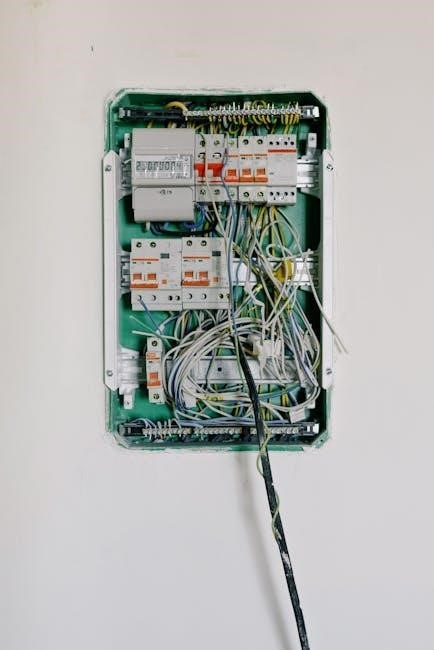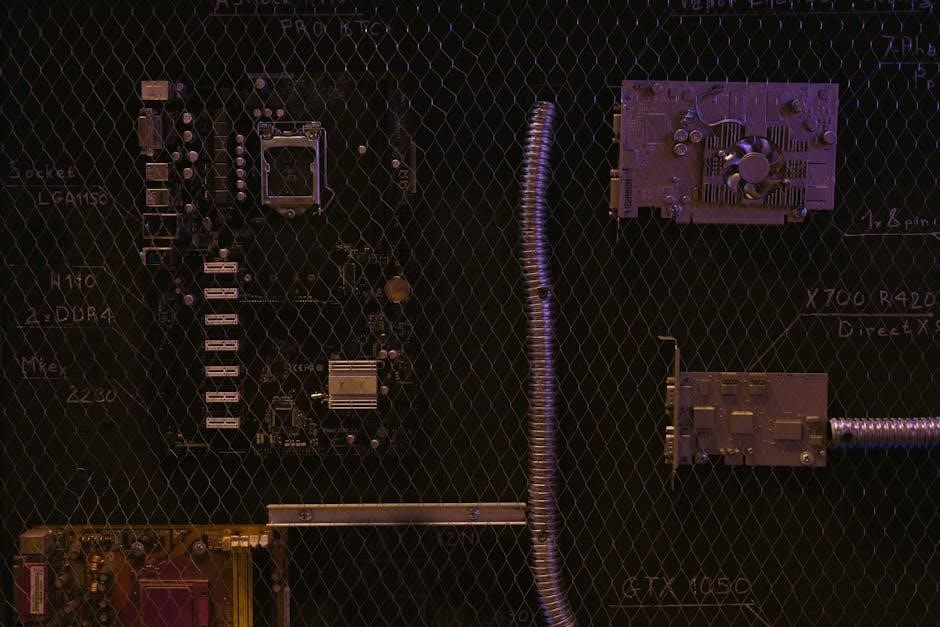
Understanding 4-way switch wiring diagrams is essential for controlling multiple lights from different locations. These diagrams provide a clear‚ visual guide for installing and connecting switches safely and efficiently. They are particularly useful for DIY enthusiasts and professionals alike‚ offering step-by-step instructions to ensure proper wiring. With a focus on safety and compliance‚ these diagrams help users avoid common mistakes and achieve reliable results.
1.1 What is a 4-Way Switch?
A 4-way switch is an electrical device used to control lighting fixtures from multiple locations. Unlike a standard single-pole switch‚ it allows for more flexibility by enabling control of a light or group of lights from three or more points. The switch operates by creating a circuit path between wires‚ ensuring the light turns on or off depending on the switch’s position. It is commonly used in staircases‚ hallways‚ or large rooms where multiple control points are needed. Understanding its function is key to interpreting wiring diagrams effectively.
1.2 Importance of Wiring Diagrams for 4-Way Switches
Wiring diagrams are crucial for safely and correctly installing 4-way switches. They provide a visual representation of the circuit‚ making it easier to understand connections between wires‚ switches‚ and lights. These diagrams help avoid common mistakes‚ such as short circuits or improper grounding. By following a wiring diagram‚ users can ensure all components are connected accurately‚ reducing the risk of electrical hazards. Diagrams also save time and frustration‚ especially for those with limited electrical experience. They are essential for compliance with safety standards and electrical codes‚ ensuring a reliable and efficient setup.
1.3 Benefits of Using a 4-Way Switch
A 4-way switch offers enhanced control flexibility and efficiency in lighting systems. It enables control of multiple lights or zones from several locations‚ ideal for large spaces. The switch supports integration with smart home systems‚ allowing advanced features like dimming and remote operation. Durable construction ensures reliability and longevity‚ while clear wiring diagrams simplify installation‚ reducing errors. Energy efficiency is improved by preventing unnecessary light usage. Overall‚ a 4-way switch provides a versatile‚ safe‚ and user-friendly solution for modern lighting needs.

Understanding the Components of a 4-Way Switch
A 4-way switch consists of key electrical components‚ including terminals and wiring connections‚ designed to control lighting circuits efficiently. Wiring diagrams provide clear visual guidance for proper installation and connectivity‚ ensuring safe and reliable operation. Understanding these components is crucial for successful setup and troubleshooting‚ making it easier to manage complex lighting systems effectively.
2.1 Key Parts of a 4-Way Switch
A 4-way switch features four terminals for connecting wires‚ enabling control of lighting from multiple locations. These terminals include input‚ output‚ and two traveler wires. The grounding terminal ensures safety by providing a path for excess current. Wiring diagrams highlight these components‚ simplifying installation. Proper understanding of these parts is crucial for efficient and safe wiring‚ ensuring reliable performance in complex lighting systems. The design allows for flexible connectivity‚ making it ideal for controlling lights from different points in a room or building.
2.2 Differences Between 3-Way and 4-Way Switches
A 3-way switch controls a single light from two locations‚ using three terminals: one common and two travelers. It’s ideal for simple setups like hallways. A 4-way switch‚ with four terminals‚ enables control from three or more locations‚ acting as an intermediary between two 3-way switches. Its complexity allows for versatile‚ multi-point control in larger spaces. Wiring diagrams show the 4-way switch connecting travelers between 3-way switches‚ offering enhanced flexibility for complex lighting systems.
2.3 Tools and Materials Needed for Wiring
To wire a 4-way switch‚ you’ll need specific tools and materials. Essential items include a voltage tester‚ wire strippers‚ screwdrivers‚ pliers‚ and copper conductors (12AWG to 14AWG). Ensure all wires are properly insulated and compatible with the switch. Safety gear like gloves and goggles is crucial. Grounding wires are mandatory for safe installation. Use a wiring diagram to identify terminals and connections accurately. Proper tools ensure secure wire fastening‚ preventing loose connections. Always follow safety guidelines to avoid electrical hazards during the process.

How to Read a 4-Way Switch Wiring Diagram
Reading a 4-way switch wiring diagram involves understanding symbols and connections. Identify terminals‚ wire colors‚ and grounding points. Follow the layout to connect wires correctly between switches and lights.
3.1 Symbols and Notations Used in Wiring Diagrams
In wiring diagrams‚ symbols represent components like switches‚ lights‚ and wires. Circles denote switches‚ while lines represent wires. Colors like black‚ red‚ and copper indicate hot‚ traveler‚ and ground wires. Symbols such as loops around terminal screws show wire connections. These notations help identify how wires attach to terminals and ensure correct installation. Understanding these symbols is crucial for interpreting the diagram accurately and safely. Proper notation helps avoid errors during wiring‚ ensuring the circuit functions as intended. Always refer to the legend for symbol meanings specific to the diagram.
3.2 Understanding Wire Colors and Their Functions
Wire colors play a critical role in identifying their functions in a 4-way switch wiring diagram. The black wire is typically the “hot” wire‚ carrying power from the electrical source. Red wires are often used as traveler wires‚ connecting switches in multi-location setups. Copper or bare wires are ground wires‚ ensuring safety by providing a path to ground. White wires usually serve as neutral wires‚ completing the circuit. Understanding these color codes is essential for accurately connecting wires to terminals and ensuring the circuit operates safely and efficiently. Proper identification prevents mistakes and ensures reliable performance.
3.3 Identifying Terminals and Connections
In a 4-way switch wiring diagram‚ terminals are labeled to indicate their purpose. The common terminal connects to the power source or load‚ while traveler terminals link switches in a multi-location setup. Properly identifying these connections ensures the circuit functions correctly. Grounding terminals are also crucial for safety‚ connecting to the grounding wire. By carefully matching wires to their respective terminals‚ you can avoid common wiring errors and ensure reliable operation of the lighting system. Accurate terminal identification is key to a safe and functional installation.

Step-by-Step Wiring Guide for a 4-Way Switch
Prepare the wiring area‚ ensuring all connections are secure. Connect wires to the switch terminals‚ looping them clockwise around screws and tightening firmly. Ensure proper grounding for safety and test the circuit to confirm functionality.
4.1 Preparing the Wiring Area
Before starting‚ ensure the wiring area is safe and accessible. Shut off the power supply and verify using a voltage tester. Inspect all wiring components for damage or wear. Plan the layout using a wiring diagram to avoid errors. Strip insulation from conductors as needed‚ following specifications. Organize wires neatly to prevent tangles. Ensure all terminals and screws are clean and secure. Loop wires clockwise around terminal screws and tighten firmly to 14-18 in-lbs. Double-check connections for accuracy before restoring power to test the circuit.
4.2 Connecting Wires to the Switch Terminals
Connect wires to the 4-way switch terminals carefully‚ following the diagram. Loop wires clockwise around terminal screws‚ securing them tightly at 14-18 in-lbs. Use copper conductors only‚ ensuring insulation is stripped 5/8 inch. Wrap side wires securely around terminals‚ avoiding loose connections. Refer to the wiring diagram to match traveler and common wires correctly. Double-check connections for accuracy and safety. Verify with a voltage tester before restoring power to test the circuit. Proper connections ensure reliable control of lights from multiple locations.
4.3 Ensuring Proper Grounding
Proper grounding is crucial for safety and functionality in 4-way switch wiring. Use metal boxes and ensure the grounding terminal is connected to all devices. Wrap copper conductors securely around the grounding terminal‚ following the diagram. In plastic boxes‚ grounding is achieved through the circuit’s ground wire. For metal boxes‚ bond all metal parts to ensure continuity. Always use copper conductors and strip insulation 5/8 inch for ground connections. Proper grounding prevents electrical hazards and ensures reliable operation of the 4-way switch system.
4.4 Testing the Circuit
After wiring‚ test the circuit to ensure proper functionality. Turn off the power at the breaker before starting. Use a voltage tester to verify no live wires. Restore power and flip each switch to check all light combinations. Ensure smooth operation without flickering or dimming. If issues arise‚ revisit connections for looseness or miswiring. Proper testing confirms the circuit’s safety and reliability‚ ensuring all components work as intended. This step is vital for identifying and resolving any potential electrical hazards or malfunctions in the 4-way switch system.
Common Configurations for 4-Way Switches
4-way switches are versatile and commonly used to control lights from multiple locations. They are often installed between two 3-way switches‚ allowing seamless operation of a single light or multiple lights from different points. This configuration is ideal for large spaces‚ such as hallways or staircases‚ where control from multiple locations is essential. The diagrams provide clear guidance for wiring these setups‚ ensuring reliable and efficient lighting control systems.
5.1 Single Light Control from Multiple Locations
Controlling a single light from multiple locations is a common application for 4-way switches. This setup typically involves two 3-way switches and one 4-way switch‚ allowing seamless operation of a single light from different points. The wiring diagram illustrates how the switches are interconnected‚ ensuring proper circuit continuity. Copper conductors are recommended for reliability‚ and grounding is essential for safety. This configuration is ideal for spaces like hallways or staircases‚ where multiple control points are necessary. Proper installation ensures efficient and safe lighting control‚ adhering to electrical codes and best practices.
5.2 Controlling Multiple Lights with a 4-Way Switch
Controlling multiple lights with a 4-way switch offers flexibility in lighting management. This configuration often involves connecting the 4-way switch with additional 3-way switches‚ creating a network to operate several lights simultaneously. The wiring diagram provides a detailed layout for connecting wires to terminals‚ ensuring all lights function seamlessly. Using copper conductors and proper grounding is crucial for safety and reliability. This setup is ideal for large spaces or rooms with multiple light fixtures‚ allowing centralized or distributed control. Proper installation ensures efficient and safe operation‚ meeting electrical standards for durability and performance.
5.3 Integrating Dimmers with 4-Way Switches
Integrating dimmers with 4-way switches enhances lighting control‚ offering precise dimming and energy efficiency. Wiring diagrams provide detailed instructions for connecting dimmers alongside 4-way switches‚ ensuring smooth operation. Proper grounding and wire insulation are critical to prevent electrical issues. Using compatible dimmer models‚ such as the Essential Forward Phase Dimmer‚ ensures seamless integration. This setup allows for dynamic lighting adjustments‚ making it ideal for modern homes. Always follow safety guidelines and manufacturer recommendations to achieve optimal performance and reliability in your lighting system.
Safety Precautions and Best Practices
Always use copper conductors and ensure proper insulation. Wrap wires securely around terminals and tighten screws firmly. Avoid overloading circuits and follow grounding guidelines to prevent electrical hazards and ensure safe wiring.
6.1 Essential Safety Tips for Wiring
Always disconnect power before starting work. Use copper conductors only‚ as specified‚ and ensure proper insulation. Ground wires are crucial for safety‚ so never omit them. Wrap conductors securely around terminals and tighten screws to the recommended torque. Avoid overloading circuits to prevent overheating. Keep wiring organized to reduce the risk of short circuits. Always follow local electrical codes and manufacturer guidelines. Regularly inspect wires and connections for wear or damage. Remember‚ safety should never be compromised to save time or materials.
6.2 Avoiding Common Mistakes
Common wiring mistakes can lead to unsafe conditions or malfunctioning systems. Ensure proper insulation and avoid using non-copper conductors. Incorrectly tightening terminal screws or wrapping wires improperly can cause poor connections. Always follow the recommended torque specifications to prevent damage. Grounding wires must never be omitted or improperly connected. Mislabeling wires or terminals can result in confusion and errors. Double-check all connections before restoring power. Using the wrong wire gauge or exceeding circuit capacity can lead to overheating. Always refer to the wiring diagram and manufacturer guidelines to avoid these pitfalls and ensure a safe‚ reliable installation.
6.3 Compliance with Electrical Codes
Adhering to electrical codes is crucial for safety and legality. Always follow local and national regulations‚ such as the National Electrical Code (NEC)‚ when wiring a 4-way switch. Ensure proper grounding‚ as specified‚ to prevent hazards. Use copper conductors exclusively‚ as required‚ and maintain correct wire gauges (12AWG to 14AWG). Proper insulation and secure connections are mandated to avoid fire risks. Compliance ensures your system is safe‚ efficient‚ and meets legal standards. Failure to adhere can result in unsafe conditions or legal consequences. Always consult local authorities for specific requirements.

Troubleshooting Common Issues
Identify and resolve issues quickly with proper troubleshooting techniques. Check for faulty connections‚ loose wires‚ or incorrect wiring configurations. Light flickering or dimming may indicate poor grounding or overloaded circuits. Test each terminal to ensure proper continuity and functionality. Verify that all wires match the diagram’s specifications. If a switch malfunctions‚ inspect for worn components or damaged terminals. Regular testing and maintenance can prevent recurring problems and ensure reliable operation of your 4-way switch system.
7.1 Identifying Faulty Connections
Faulty connections are a common cause of electrical issues in 4-way switch setups. Begin by visually inspecting all wire connections for signs of damage‚ fraying‚ or corrosion. Use a multimeter to test continuity between terminals and ensure wires are securely attached. Loose connections or incorrect wire placement can disrupt the circuit. Refer to your wiring diagram to verify that all connections match the specified configuration. If a connection fails the continuity test‚ it may indicate a broken wire or improper installation. Addressing these issues promptly prevents further complications and ensures reliable operation.
7.2 Diagnosing Light Flickering or Dimming
Flickering or dimming lights can indicate issues in your 4-way switch wiring. Start by checking the connections at the switch and light fixtures for looseness or corrosion. Use a multimeter to measure voltage drops across the circuit. Consult your wiring diagram to ensure all connections are correct. If the issue persists‚ inspect for faulty wires or overloaded circuits. Flickering may also result from incorrect wire gauges or poor grounding. Addressing these problems promptly ensures consistent light performance and prevents potential electrical hazards. Always refer to your diagram for guidance.
7.3 Resolving Switch Malfunction
If a 4-way switch stops functioning properly‚ start by disconnecting power and inspecting the switch and connections. Check for loose wires or corrosion and tighten or clean them as needed. If damage is found‚ replace the switch. Consult your wiring diagram to ensure all connections match the intended configuration. Test the circuit to confirm functionality. Persistent issues may require examining other components‚ such as the light fixtures or additional switches in the circuit. Proper troubleshooting ensures reliable operation and prevents further electrical issues. Always follow safety guidelines when working with live circuits.
Advanced Topics in 4-Way Switch Wiring
Explore advanced techniques for 4-way switch integration‚ including smart home automation and complex lighting systems. Learn to incorporate remote controls and dimmers seamlessly for enhanced functionality and convenience. These methods optimize performance and versatility‚ offering tailored solutions for modern electrical setups. Detailed wiring diagrams and expert tips guide you through sophisticated configurations‚ ensuring reliability and efficiency in every application.
8.1 Smart Home Integration with 4-Way Switches
Integrate 4-way switches with smart home systems for advanced lighting control. By connecting these switches to smart hubs or controllers‚ you can enable remote operation and voice commands. Compatibility with systems like Zigbee or Z-Wave allows seamless integration. Smart switches offer features like dimming‚ scheduling‚ and energy monitoring. Wiring diagrams provide detailed guidance for installation‚ ensuring proper connections between switches‚ hubs‚ and lights. This setup enhances convenience‚ efficiency‚ and customization‚ making it ideal for modern smart homes. Always follow safety guidelines and manufacturer instructions for reliable performance.
8.2 Using 4-Way Switches in Complex Lighting Systems
4-way switches are ideal for managing complex lighting systems with multiple controls. They allow seamless integration of several switches to operate a single or group of lights. In advanced setups‚ these switches enable zone control‚ dimming‚ and remote operation. Proper wiring ensures synchronization across all switches. Detailed diagrams guide the installation‚ highlighting connections for travelers and common wires. This configuration enhances flexibility and reliability in large-scale lighting systems‚ making it easier to customize illumination levels and patterns for different spaces and functionalities.
8.3 Incorporating Remote Controls
Remote controls add convenience and flexibility to 4-way switch systems. By integrating wireless or infrared technology‚ users can operate lights without physical switch interaction. This is ideal for smart home setups or hard-to-reach locations. Remote controls often require additional components like receivers or hubs. Detailed wiring diagrams guide the connection of these elements to the 4-way switch‚ ensuring seamless communication. Proper installation ensures reliable performance and enhances the overall lighting control experience. This modern solution simplifies daily use while maintaining the system’s integrity and functionality.
Maintenance and Upkeep of 4-Way Switches
Regular maintenance ensures optimal performance and longevity of 4-way switches. Cleaning terminals‚ inspecting wires‚ and replacing worn parts are essential tasks. Proper upkeep prevents electrical issues and ensures safety.
9.1 Cleaning and Inspecting the Switch
Regular cleaning and inspection of a 4-way switch are crucial for maintaining its functionality. Use a soft‚ dry cloth to wipe away dirt or debris from the terminals and exterior. Inspect the wires for signs of wear‚ oxidation‚ or loose connections. Ensure all terminals are secure and tightened properly. Cleaning and inspecting help prevent electrical issues and ensure reliable performance. Always disconnect power before performing maintenance to avoid shocks or damage. This routine upkeep extends the switch’s lifespan and maintains safety standards.
9.2 Replacing Worn-Out Components
Replacing worn-out components in a 4-way switch is vital for maintaining its performance. Identify and inspect damaged or corroded parts‚ such as terminals or wires. Disconnect power before starting repairs. Use replacement parts that match the original specifications. Refer to the wiring diagram PDF for guidance on correct installation. Tighten connections securely to prevent loose wires. After replacement‚ test the switch to ensure proper functionality. Regular inspections and timely replacements prevent electrical hazards and ensure long-term reliability of the switch and connected lighting systems.
9.3 Regular Testing for Optimal Performance
Regular testing of a 4-way switch ensures optimal performance and identifies potential issues early. Start by turning off the power supply and verifying the circuit is safe to work on. Use a multimeter to check continuity and resistance across terminals. Test each switch position to confirm proper light control. Inspect all wire connections for looseness or damage. Perform these checks annually or after major electrical work. This proactive approach helps maintain reliable operation‚ prevents unexpected malfunctions‚ and extends the lifespan of the switch and connected lighting systems. Always follow safety guidelines during testing.

Resources for Further Learning
Explore detailed PDF guides and manuals for 4-way switch wiring. Utilize online tutorials and videos for visual guidance. Join forums and communities for expert advice and troubleshooting tips.
10.1 Recommended PDF Guides and Manuals
Download free 4-way switch wiring diagram PDFs for comprehensive guides. These manuals include detailed wiring layouts‚ installation tips‚ and troubleshooting steps. They cover various configurations‚ such as controlling multiple lights or integrating dimmers. Many PDFs offer visual diagrams and step-by-step instructions‚ making complex wiring tasks easier. Look for guides that include safety precautions and material lists. These resources are ideal for DIY enthusiasts and professionals seeking clear‚ actionable information to master 4-way switch wiring projects efficiently and safely.
10.2 Online Tutorials and Videos
Online tutorials and videos provide hands-on guidance for wiring 4-way switches. Platforms like YouTube and specialized electrical websites offer detailed step-by-step videos. These resources often include visual demonstrations of wiring diagrams‚ making complex connections easier to understand. Many tutorials cover common setups‚ troubleshooting‚ and advanced configurations. They are ideal for visual learners and those who prefer practical examples. Additionally‚ some videos include tips for safety and best practices‚ ensuring a successful wiring project. These resources complement PDF guides‚ offering a comprehensive learning experience for all skill levels.
10.3 Forums and Communities for Support
Forums and communities are invaluable resources for troubleshooting and advice on 4-way switch wiring. Platforms like Reddit’s r/HomeImprovement or specialized electrical forums offer spaces to ask questions and share experiences. Many users post detailed threads about their wiring projects‚ including challenges and solutions. These communities often include experienced professionals and DIY enthusiasts willing to provide guidance. Engaging with these forums can help resolve specific issues and gain insights from real-world applications. They also serve as a platform to showcase successful projects and inspire others. This collective knowledge is a powerful tool for anyone working with 4-way switches.
Mastering 4-way switch wiring is easy with PDF guides and tutorials. Follow safety tips for successful installations and further exploration for enhanced skills.
11.1 Summary of Key Points
Understanding 4-way switch wiring diagrams is crucial for controlling lights from multiple locations. Key components include terminals‚ wire colors‚ and proper grounding. Essential tools and safety precautions ensure successful installations. Advanced configurations‚ like integrating dimmers or smart home systems‚ expand functionality. Troubleshooting common issues‚ such as faulty connections or flickering lights‚ is made easier with detailed diagrams. Resources like PDF guides and online tutorials provide further learning opportunities. This guide offers practical advice‚ ensuring safe and efficient wiring for both beginners and experienced users‚ while inspiring exploration of complex lighting setups.
11.2 Final Tips for Successful Wiring
For a successful 4-way switch wiring project‚ always follow the diagram carefully and ensure all connections are secure. Use copper conductors and remove insulation precisely as instructed. Loop wires clockwise 3/4 turns around terminals and tighten screws to 14-18 in lbs. Proper grounding is essential for safety. Test the circuit thoroughly after wiring to ensure functionality. Keep the area clean and well-lit to avoid mistakes. Refer to online resources or forums if issues arise. By adhering to these guidelines‚ you can achieve a safe and efficient wiring setup.
11.3 Encouragement for Further Exploration
Mastering 4-way switch wiring opens doors to more complex projects and advanced electrical setups. Explore resources like PDF guides‚ online tutorials‚ and forums for deeper insights. Consider integrating smart home technology or exploring dimmer configurations. Practice regularly to refine your skills and stay updated with the latest trends in electrical wiring. The more you experiment and learn‚ the more confident you’ll become in tackling challenging projects. Embrace the journey of continuous improvement and enjoy the satisfaction of creating efficient‚ reliable lighting systems.



